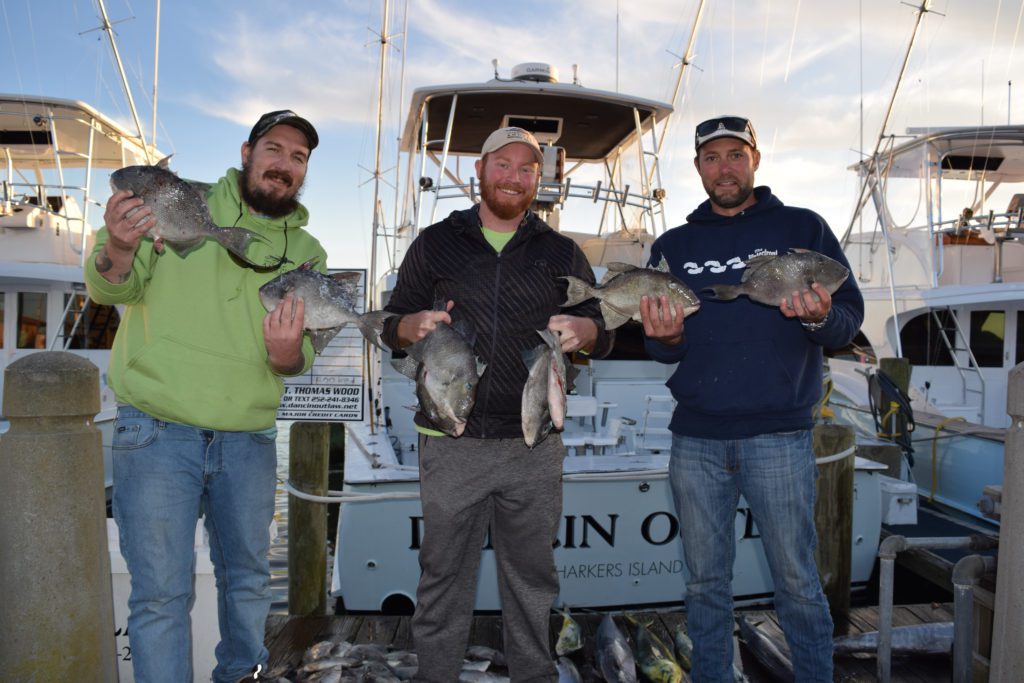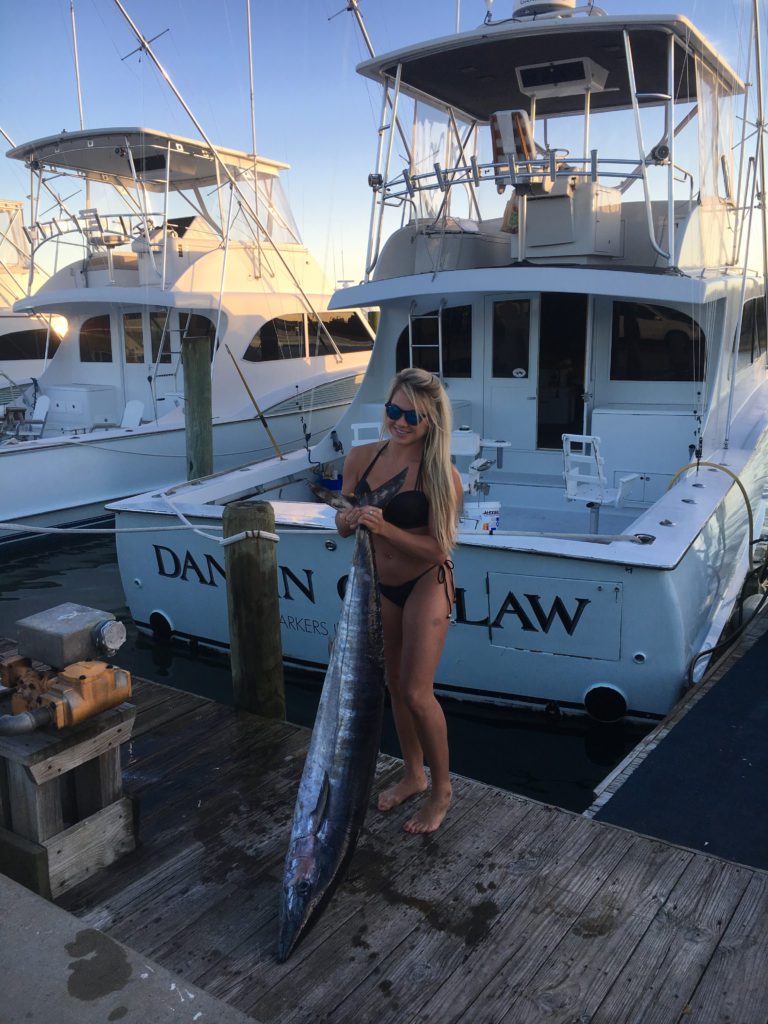Tidelines – December 14, 2017
Though Capt. Thomas Wood, of Dancin’ Outlaw Charters out of the Morehead City waterfront, would rather this Tidelines focus on the wahoo, blackfins, and mahi we picked up on the troll during our annual fall/winter trip with him and his Mate Michael Tickle, my attention keeps going back to the hot triggerfish bite that started off our day together.
While I’ve caught triggers a number of times before, I’ve never caught them anything like we did on that mid-November morning 35 miles out of Beaufort Inlet in about 22 fathoms.
Sure, the total catch numbers were impressive, as we counted 99 triggerfish running from 2-4 lbs. each (with a few pushing 5 lbs.) coming out of the box once back at the docks, but what struck me as odd and exceptional was that with all the hooks and all the bait we sent down to the bottom, we basically brought up triggerfish and only triggerfish. There was no bycatch at all, other than three small almaco jacks. That’s a ratio of 99 target species to 3 non-target.
Many Fisherman’s Post readers have a lot more bottom fishing time in than I, but for me part of the fun of bottom fishing is that you never know what you might bring up. Apparently that philosophy doesn’t apply when you ask Thomas and Michael to take you triggerfishing.
So while I found it odd that we brought up trigger after trigger—with no sea bass, no beeliners, no grunts, no ringtails, no small sharks, nothing else but triggerfish—Thomas and Michael were expecting those results.

Ryan Christoffersen, John Workman, and J.J. Khoury with a handful of the numerous triggerfish they picked up using cut
They had us on a big area of hard, live bottom without much relief. The triggerfish, Michael explained, like to gather there to root around on the bottom for crabs and other small food sources that collect amongst the growth formed on this shelly, rocky area.
“Sometimes they’ll eat a piece of squid just as good, but they seem to like red meat better,” Michael told me as he cut up a section of false albacore into small pieces. “A fresh piece of albacore—that’s the way to go.”
While the commercial guys will rig up with 4-5 hooks, each of us had two-hook bottom rigs with 2/0 live bait circle hooks spread apart about 2-3 feet. The triggerfish will stack up on the bottom once they get schooled together, so having two hooks set apart helps cover more of water. In addition, the distance between hooks helps keep the lines from tangling on the drop, and then also helps keep the lines from tangling when you’re bringing up two triggers at a time that start cartwheeling as they get closer to the boat.
We landed singles on the bottom hook, we landed singles on the top hook, and we landed doubles, and it didn’t seem to matter whether we dropped albacore or squid. The bite was on. Part of our success that morning, Michael told me later, was that we had the right conditions for successful drifts.
While a boat certainly could anchor to target triggerfish, Thomas’ 56’ custom sportfisher built by C&L Boatworks doesn’t really want to anchor offshore, so the friendly 0.5 knots of tide and light wind was perfect for making a series of long drifts. Once you get up to 1.5-2.0 knots of tide, Thomas agreed, you’re moving too fast to be effective.
The classic triggerfish bite, it seems, is a double tap, and once you feel that double tap you basically have two options—set the hook with the steady pressure of reeling, or set the hook with the little, short jab of a hook set and then start reeling.
The discipline of not reacting by setting the hook can be a challenge when you feel that bite, but we mostly kept honest and found better success with the reel-reel-reel hook set. And when it was clear that the bite was hot, we incorporated a third option—reel-reel-reel to set the hook, and then drop the rig back down to the bottom to try and get a second fish on the second hook.
Sometimes the third option worked and we brought up two fish. Sometimes it didn’t and we brought up two empty hooks, losing the first fish in the greed of trying for two. The fun was that it didn’t matter—just drop back down.
Thomas and Michael, like us, were pleased with the results of our morning bottom fishing session, but they were ready to get back to their roots and start trolling for bigger fish. So we packed away the lighter action bottom rods and pulled ballyhoo while headed north to the Big Rock area.
Thomas and Michael, as the Fisherman’s Post crew knows from experience, are big on hospitality, and they showed that hospitality almost immediately. They located a couple of wahoo almost as soon as the first spread was set, and then found a handful of mahi and blackfins before raising more wahoo.
The most impressive show of Dancin’ Outlaw hospitality, though, wasn’t the successful box full of an assortment of delicious fish. As we got back in cell phone range, Michael called one of his friends at Calcutta and arranged to have a Calcutta model meet us at the docks to take some promotional photos. You probably won’t notice the first time you look at her photo, and maybe not even the second time, but if you look long enough you’ll see that she’s posing with one of our bigger wahoo.

A Calcutta model holds up one of the wahoo caught on a recent Fisherman’s Post trip out of the Morehead City waterfront. The crew was fishing with Capt. Thomas Wood and Mate Michael Tickle on the charter boat “Dancin Outlaw.”
If you like the idea of fishing with two of the more talented and friendly anglers in the Morehead City charter fleet, then call Capt. Thomas Wood at (252) 241-8346 or visit online at www.dancinoutlaw.net to book a trip on the Dancin’ Outlaw. Be sure to ask for the “Calcutta model” fishing trip. My suggestion is to request a petite model, because we all know smaller hands make your fish look bigger.
Please enjoy our winter issue, and we’ll see you again on March 22—our first issue of 2018.





